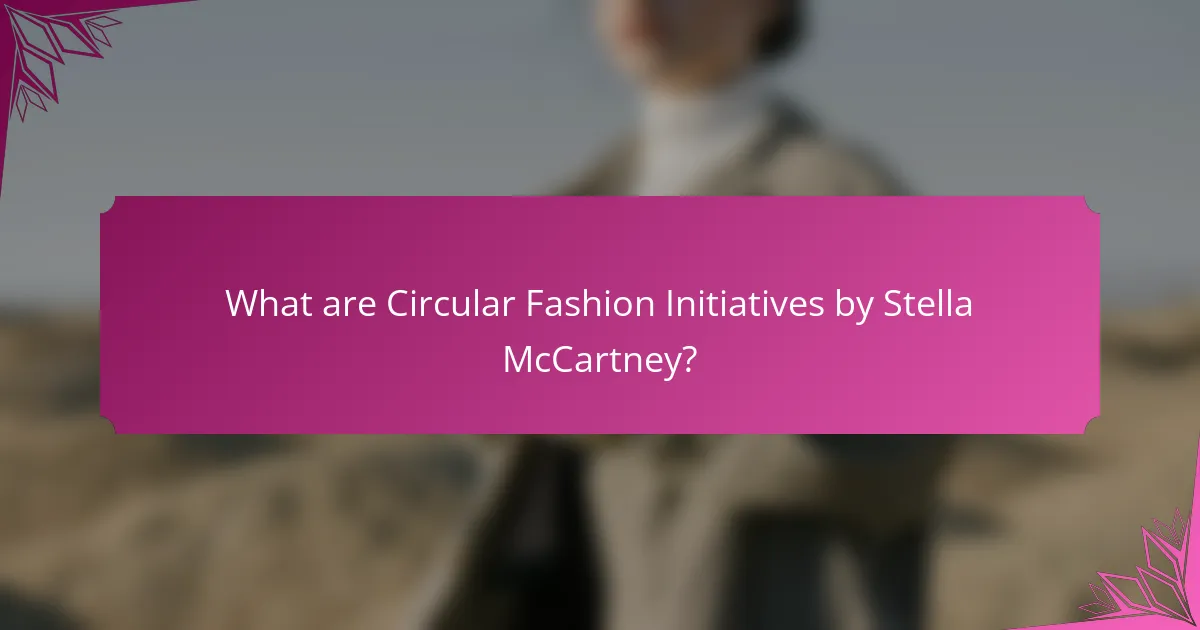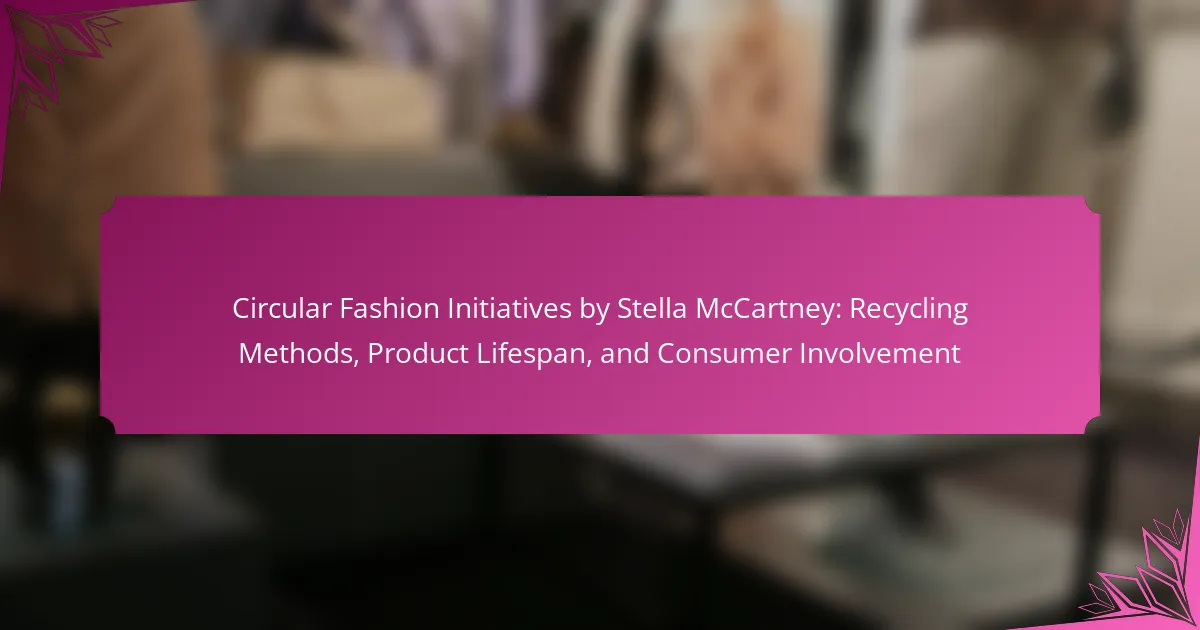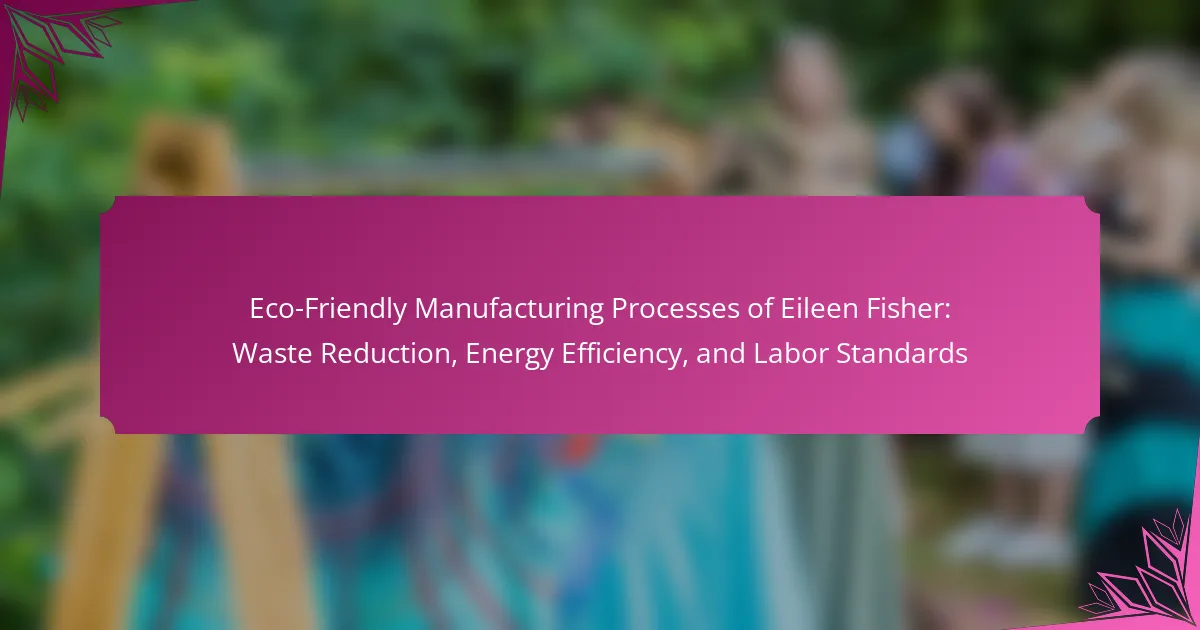Stella McCartney is a leading brand in circular fashion, focusing on sustainability and waste reduction through innovative practices. The brand utilizes eco-friendly materials, such as organic cotton, recycled polyester, and regenerated cashmere, and promotes a garment take-back program for recycling and resale. Key initiatives include employing recycling methods like upcycling and closed-loop systems, which minimize the need for virgin materials. Additionally, Stella McCartney emphasizes extending product lifespan through high-quality craftsmanship, timeless design, and repair services, fostering a culture of sustainability and responsible consumer behavior.

What are Circular Fashion Initiatives by Stella McCartney?
Stella McCartney’s circular fashion initiatives focus on sustainability and reducing waste. The brand emphasizes the use of eco-friendly materials. These include organic cotton, recycled polyester, and regenerated cashmere. Stella McCartney also promotes a take-back program for end-of-life products. This initiative encourages consumers to return their used garments for recycling or resale. The brand collaborates with organizations to enhance circularity in fashion. They aim to extend the product lifespan through quality craftsmanship. Stella McCartney’s initiatives align with the broader goal of creating a closed-loop fashion system.
How does Stella McCartney define circular fashion?
Stella McCartney defines circular fashion as a system that prioritizes sustainability and resource efficiency. It involves designing products that can be reused, repaired, and recycled. This approach minimizes waste and reduces the environmental impact of fashion. McCartney emphasizes the importance of creating a closed-loop system. In this system, materials are continuously cycled back into production. This method contrasts with the traditional linear fashion model, which often leads to excess waste. McCartney’s brand actively incorporates these principles into its practices. By focusing on circular fashion, she aims to inspire a shift in the industry towards more responsible consumption.
What principles underpin Stella McCartney’s approach to circular fashion?
Stella McCartney’s approach to circular fashion is underpinned by sustainability, innovation, and transparency. Sustainability focuses on reducing environmental impact through eco-friendly materials. McCartney prioritizes the use of organic cotton, recycled polyester, and sustainable leather alternatives. Innovation involves creating designs that promote longevity and recyclability. The brand integrates cutting-edge techniques to enhance product durability. Transparency reflects McCartney’s commitment to ethical practices in fashion production. The brand openly shares its supply chain practices and environmental goals. These principles collectively aim to create a closed-loop system in the fashion industry. This system minimizes waste and encourages responsible consumption.
What role does sustainability play in these initiatives?
Sustainability is a core principle in Stella McCartney’s circular fashion initiatives. It drives the design and production processes to minimize environmental impact. The brand emphasizes the use of eco-friendly materials, such as organic cotton and recycled polyester. This approach reduces waste and resource consumption. Additionally, sustainability promotes longer product lifespans through quality craftsmanship. The initiatives also encourage consumer involvement in recycling and responsible consumption. By engaging consumers, Stella McCartney fosters a culture of sustainability in fashion. These efforts align with global goals to combat climate change and promote ethical practices.
What are the main goals of Stella McCartney’s circular fashion initiatives?
The main goals of Stella McCartney’s circular fashion initiatives are to reduce waste and promote sustainability. These initiatives aim to create a closed-loop system in fashion. This system allows for the recycling and repurposing of materials. McCartney focuses on using sustainable materials in her collections. She emphasizes the importance of longevity in product design. This approach encourages consumers to buy less and invest in quality items. Additionally, her initiatives aim to educate consumers about sustainable practices. By doing so, she seeks to foster a more responsible fashion industry.
How does the brand aim to reduce waste through these initiatives?
Stella McCartney aims to reduce waste through circular fashion initiatives by implementing recycling methods and promoting sustainable practices. The brand utilizes recycled materials in its products, which minimizes the need for new resources. It also encourages consumers to return used items for recycling, fostering a closed-loop system. Additionally, Stella McCartney designs products for longevity, ensuring they have a longer lifespan. This approach reduces the frequency of disposal and waste generation. By educating consumers on sustainable practices, the brand enhances awareness of waste reduction. These initiatives collectively contribute to a significant decrease in environmental impact.
What impact does Stella McCartney hope to have on the fashion industry?
Stella McCartney hopes to drive sustainability and ethical practices in the fashion industry. She aims to reduce environmental impact through circular fashion initiatives. Her brand focuses on using eco-friendly materials and innovative recycling methods. McCartney advocates for transparency in the supply chain. She seeks to educate consumers about the importance of sustainable fashion. Her initiatives promote longer product lifespans and responsible consumption. McCartney’s approach challenges traditional fashion norms and encourages industry-wide change. This commitment aligns with global efforts to combat climate change and promote ethical consumerism.

What recycling methods are employed in Stella McCartney’s initiatives?
Stella McCartney employs several recycling methods in her initiatives. These methods include upcycling materials from previous collections. She also utilizes closed-loop recycling systems to reduce waste. Additionally, the brand incorporates recycled fabrics in new products. This approach minimizes the need for virgin materials. The company actively promotes garment take-back programs. These programs encourage consumers to return used items for recycling. Stella McCartney’s commitment to sustainability is evident in these practices. By implementing these recycling methods, the brand aims to create a circular fashion model.
How does the brand utilize recycling in its production processes?
Stella McCartney utilizes recycling in its production processes by incorporating recycled materials into its fabrics. The brand sources recycled polyester and nylon, reducing reliance on virgin resources. This practice minimizes waste and lowers the environmental impact of production. Stella McCartney also employs a circular design approach, encouraging product longevity and recyclability. The brand’s commitment to sustainability is evidenced by its use of innovative materials, such as regenerated cashmere. These efforts align with the principles of circular fashion, promoting a closed-loop system in the fashion industry.
What materials are commonly recycled in Stella McCartney’s products?
Stella McCartney commonly recycles materials such as polyester, nylon, and cotton in her products. These materials are sourced from post-consumer waste and industrial scraps. Recycled polyester is made from plastic bottles, reducing landfill waste. Recycled nylon often comes from discarded fishing nets, contributing to ocean cleanup. Recycled cotton is sourced from textile waste, minimizing resource use. This commitment aligns with Stella McCartney’s focus on sustainability and circular fashion. The brand aims to reduce environmental impact through innovative recycling methods.
How does the recycling process work for these materials?
The recycling process for materials in circular fashion initiatives involves several key steps. First, materials are collected from consumers and businesses. Next, they are sorted based on type and quality. This sorting ensures that similar materials are processed together. After sorting, the materials undergo cleaning to remove contaminants. This step is crucial for maintaining the integrity of the recycled material.
Following cleaning, the materials are shredded into smaller pieces. This makes them easier to process in the next stages. The shredded materials are then melted down or chemically processed, depending on the type of material. This transformation allows the creation of new raw materials. Finally, the recycled materials are manufactured into new products, completing the cycle.
Stella McCartney’s initiatives focus on sustainable practices throughout this process. They emphasize the importance of reducing waste and promoting the use of recycled materials in fashion.
What innovative recycling technologies are used by Stella McCartney?
Stella McCartney utilizes several innovative recycling technologies in her fashion line. One key technology is the use of recycled polyester made from plastic bottles. This process transforms waste into high-quality fabric, reducing landfill contributions. Additionally, she employs a closed-loop recycling system for denim, allowing old jeans to be recycled into new ones. Another method includes the use of bio-based materials that can be regenerated. These technologies aim to minimize environmental impact and promote sustainable fashion practices. Stella McCartney’s commitment to these methods showcases her leadership in circular fashion initiatives.
How do these technologies enhance product sustainability?
Technologies enhance product sustainability by enabling efficient recycling and reducing waste. Advanced recycling methods allow materials to be repurposed, minimizing the need for new resources. For instance, Stella McCartney utilizes innovative processes to recycle textiles, which lowers environmental impact. These technologies also extend product lifespan through durable design and quality materials. Research indicates that products designed for longevity reduce consumption rates. Additionally, consumer involvement in sustainable practices is facilitated by digital platforms that promote awareness. This engagement further supports sustainable consumption patterns.
What partnerships has Stella McCartney formed to improve recycling methods?
Stella McCartney has formed partnerships with various organizations to enhance recycling methods. Notably, she collaborated with the sustainability-focused company, Evrnu. This partnership aims to transform textile waste into new fabric. Additionally, McCartney works with organizations like the Ellen MacArthur Foundation. This collaboration focuses on promoting circular economy principles in fashion. Another significant partnership is with the fashion platform, The RealReal. This alliance encourages the resale and recycling of luxury fashion items. These partnerships demonstrate her commitment to sustainable practices in the fashion industry.

How does Stella McCartney extend the product lifespan?
Stella McCartney extends the product lifespan through sustainable design practices and innovative materials. The brand uses high-quality, durable fabrics that resist wear and tear. This approach minimizes the need for frequent replacements. Stella McCartney also emphasizes timeless styles that encourage long-term use. The brand promotes repair and recycling initiatives to prolong product life. For instance, they offer services to repair damaged items. This reduces waste and encourages consumers to keep products longer. Additionally, the brand educates consumers on caring for their garments. This fosters a culture of sustainability and responsible consumption.
What strategies does the brand implement to promote longevity in its products?
Stella McCartney implements several strategies to promote longevity in its products. The brand emphasizes high-quality materials that enhance durability. These materials include organic cotton, recycled polyester, and innovative biodegradable fabrics. Stella McCartney designs products for timelessness, reducing the need for frequent replacements. The brand also encourages proper care through clear maintenance guidelines, extending product lifespan. Additionally, it promotes repair services, allowing customers to fix rather than discard items. By focusing on these strategies, Stella McCartney aligns with sustainable practices and reduces environmental impact.
How does design play a role in extending product lifespan?
Design plays a crucial role in extending product lifespan by prioritizing durability and repairability. Thoughtful design reduces wear and tear, allowing products to withstand usage over time. Incorporating high-quality materials enhances longevity and minimizes the need for replacements. Modular designs enable easier repairs and upgrades, promoting a longer lifecycle. Additionally, aesthetic choices can influence consumer attachment, encouraging users to keep products longer. Research indicates that products designed for longevity can reduce waste by up to 80%. This approach aligns with circular fashion principles, as seen in Stella McCartney’s initiatives.
What maintenance tips does Stella McCartney provide for consumers?
Stella McCartney provides several maintenance tips for consumers to extend the lifespan of their products. Consumers are advised to wash items at lower temperatures to save energy. Air drying instead of using a dryer is recommended to preserve fabric quality. Regularly checking for loose threads and repairing them promptly can prevent further damage. Storing items in a cool, dry place helps maintain their condition. These practices support sustainability and align with McCartney’s commitment to circular fashion.
How does consumer involvement contribute to product lifespan?
Consumer involvement significantly enhances product lifespan. Engaged consumers tend to take better care of their products. They are more likely to follow maintenance guidelines and repair items when necessary. This behavior reduces wear and tear, ultimately extending the product’s usable life. Research shows that consumers who are emotionally invested in a product are less likely to discard it prematurely. A study by the Ellen MacArthur Foundation highlights that increased consumer awareness can lead to a 30% reduction in waste. Thus, consumer involvement directly correlates with improved product longevity.
What role does education play in consumer participation in circular fashion?
Education plays a crucial role in consumer participation in circular fashion. It increases awareness of sustainable practices and the environmental impact of fashion choices. Educated consumers are more likely to engage in recycling, upcycling, and responsible purchasing. Studies show that informed consumers tend to prefer brands that prioritize sustainability. Additionally, education fosters a sense of responsibility towards the environment. Knowledge about circular fashion can lead to changes in consumer behavior, promoting longer product lifespans. Research indicates that educational initiatives can significantly boost participation rates in circular economy practices.
How can consumers actively participate in Stella McCartney’s initiatives?
Consumers can actively participate in Stella McCartney’s initiatives by engaging in sustainable fashion practices. They can recycle their old Stella McCartney products through designated recycling programs. Additionally, consumers can support the brand by purchasing items made from eco-friendly materials. Participating in awareness campaigns organized by the brand also fosters community involvement. Moreover, consumers can share their experiences on social media to promote sustainability. Engaging in educational workshops hosted by Stella McCartney enhances understanding of circular fashion. These actions collectively contribute to the brand’s mission of promoting sustainable practices in the fashion industry.
What practical steps can consumers take to support circular fashion?
Consumers can support circular fashion by choosing second-hand clothing. Buying from thrift stores reduces waste and promotes reuse. Participating in clothing swaps encourages sharing and extends garment life. Repairing clothing instead of discarding it minimizes landfill contributions. Supporting brands with sustainable practices fosters a circular economy. Educating themselves about sustainable materials helps consumers make informed choices. Advocating for policies that promote recycling can influence industry standards. Lastly, donating unwanted clothing ensures it can be reused or recycled effectively.
Circular Fashion Initiatives by Stella McCartney focus on sustainability, waste reduction, and the promotion of eco-friendly materials such as organic cotton and recycled polyester. The brand implements a take-back program for used garments, encouraging recycling and responsible consumption. Key principles include innovation, transparency, and extending product lifespan through high-quality craftsmanship. Stella McCartney collaborates with various organizations to enhance recycling methods and educate consumers on sustainable practices, aiming to foster a closed-loop system in the fashion industry. The article will explore these initiatives, their impact on the fashion sector, and practical steps consumers can take to support circular fashion.




